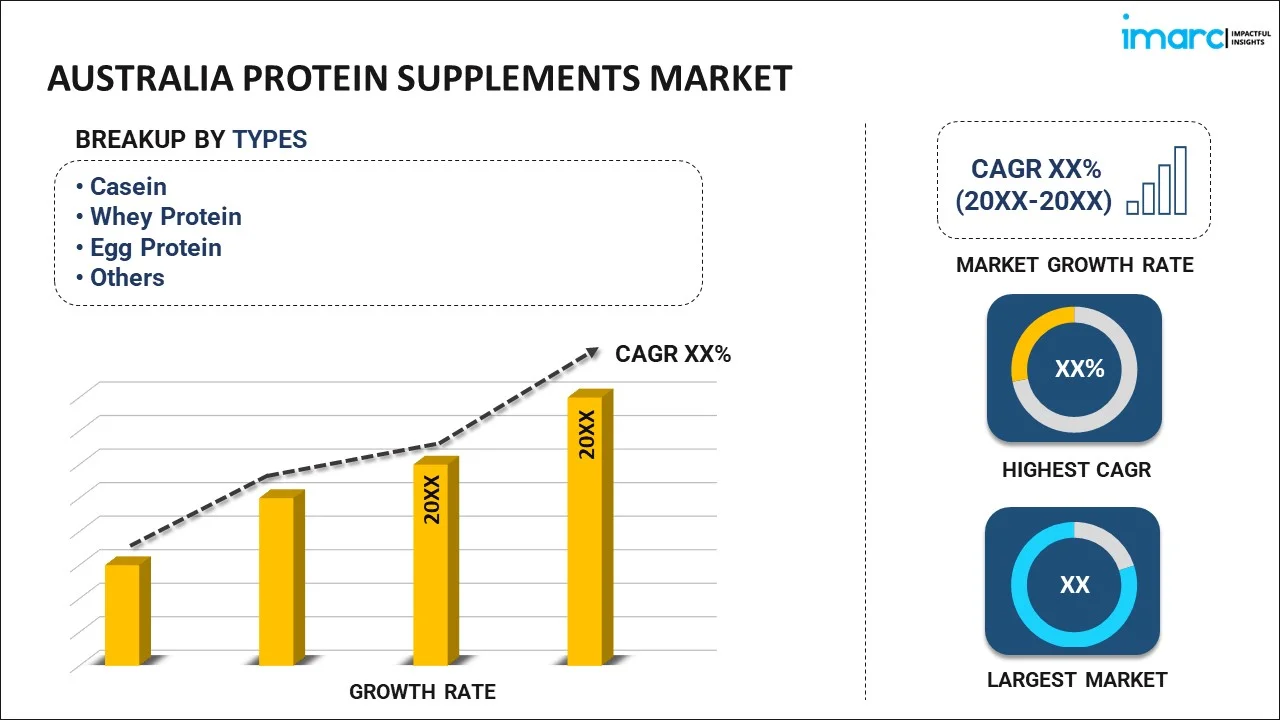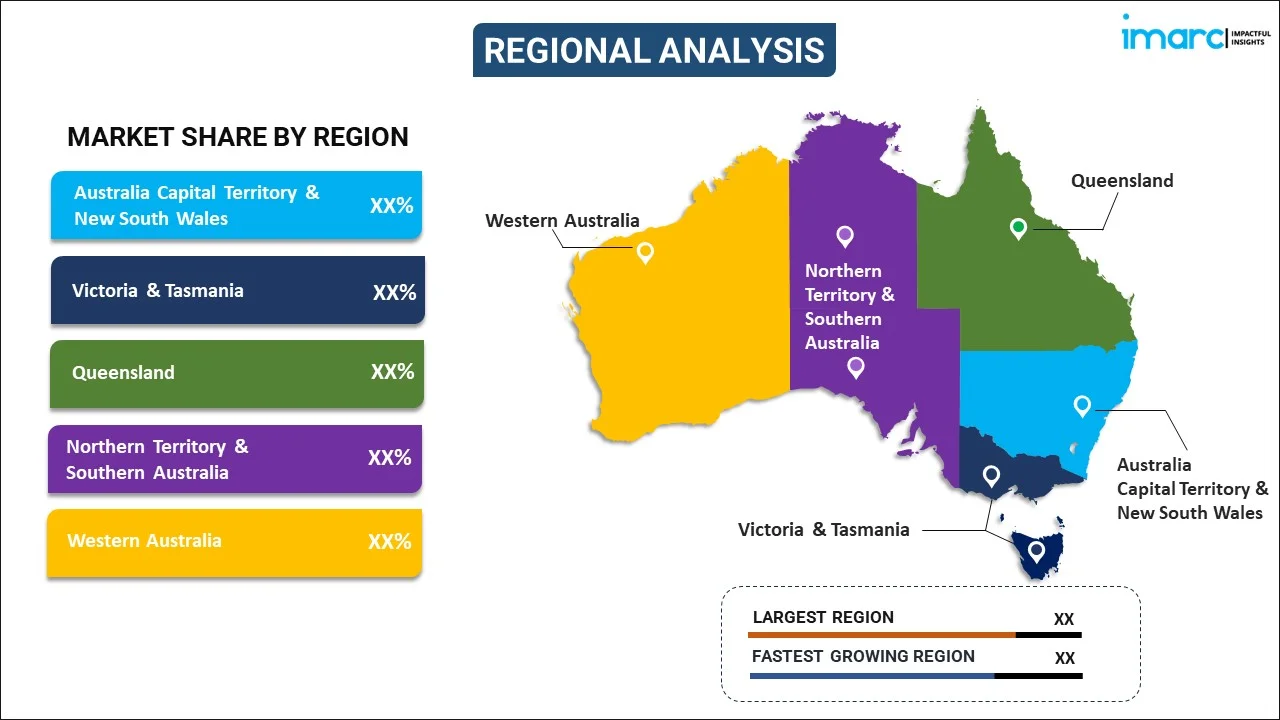
Australia Protein Supplements Market Report by Type (Casein, Whey Protein, Egg Protein, Soy Protein, and Others), Form (Protein Powder, Protein Bars, Ready to Drink, and Others), Source (Animal-Based, Plant-Based), Application (Sports Nutrition, Functional Food), Distribution Channel (Supermarkets and Hypermarkets, Online Stores, Direct to Customers (DTC), and Others), and Region 2024-2032
Market Overview:
Australia protein supplements market size is projected to exhibit a growth rate (CAGR) of 7.60% during 2024-2032. Numerous leading players across the country are extensively investing in the development of innovative product variants infused with diversified flavors, which is primarily stimulating the market growth.
|
Report Attribute
|
Key Statistics
|
|---|---|
|
Base Year
|
2023 |
|
Forecast Years
|
2024-2032 |
|
Historical Years
|
2018-2023
|
| Market Growth Rate (2024-2032) | 7.60% |
Protein supplements represent concentrated protein sources derived from diverse origins, such as whey, casein, soy, pea, egg, etc. They are widely utilized by individuals with numerous objectives, including muscle development, weight management, fulfilling daily dietary requirements, etc. The manufacturing process involves extraction, purification, drying, and yielding of these supplements in the form of powders, bars, or shakes. Essential amino acids provided by protein supplements play a crucial role in various bodily functions, encompassing muscle repair, immune system reinforcement, enzyme production, etc. These supplements help in muscle recovery and meeting overall protein needs. This is particularly valuable for individuals with limited dietary options or specific fitness objectives.
Australia Protein Supplements Market Trends:
The Australia protein supplements market is experiencing significant growth, driven by the rising consumer consciousness towards fitness and wellness routine. This heightened awareness serves as a primary driver for the market expansion. Moreover, the evolving lifestyle patterns, including a surge in fitness activities and the increasing focus on weight management, contribute to the widespread adoption of protein supplements across the country. Individuals in Australia are recognizing the convenience and effectiveness of these supplements and are incorporating them into their daily routines to meet their nutritional goals. Additionally, the growing number of fitness enthusiasts, athletes, and consumers pursuing active lifestyles is acting as another significant growth-inducing factor. Besides this, the elevating need for quick and efficient protein intake post-exercise for muscle recovery is also augmenting the market growth in Australia. Furthermore, continuous innovations in product formulations, with manufacturers introducing diverse protein sources and flavors to cater to varied consumer preferences, are stimulating the market growth. Strategic marketing and product positioning also play a crucial role, influencing individual choices in a competitive landscape. In conclusion, the increasing participation in fitness and athletic activities and the inflating popularity of recreational sports events are expected to fuel the Australia protein supplements market in the coming years.
Australia Protein Supplements Market Segmentation:
IMARC Group provides an analysis of the key trends in each segment of the market, along with forecasts at the country level for 2024-2032. Our report has categorized the market based on type, form, source, application, and distribution channel.
Type Insights:

- Casein
- Whey Protein
- Egg Protein
- Soy Protein
- Others
The report has provided a detailed breakup and analysis of the market based on the type. This includes casein, whey protein, egg protein, soy protein, and others.
Form Insights:
- Protein Powder
- Protein Bars
- Ready to Drink
- Others
A detailed breakup and analysis of the market based on the form have also been provided in the report. This includes protein powder, protein bars, ready to drink, and others.
Source Insights:
- Animal-Based
- Plant-Based
The report has provided a detailed breakup and analysis of the market based on the source. This includes animal-based and plant-based.
Application Insights:
- Sports Nutrition
- Functional Food
A detailed breakup and analysis of the market based on the application have also been provided in the report. This includes sports nutrition and functional food.
Distribution Channel Insights:
- Supermarkets and Hypermarkets
- Online Stores
- Direct to Customers (DTC)
- Others
The report has provided a detailed breakup and analysis of the market based on the distribution channel. This includes supermarkets and hypermarkets, online stores, direct to customers (DTC), and others.
Regional Insights:

- Australia Capital Territory & New South Wales
- Victoria & Tasmania
- Queensland
- Northern Territory & Southern Australia
- Western Australia
The report has also provided a comprehensive analysis of all the major regional markets, which include Australia Capital Territory & New South Wales, Victoria & Tasmania, Queensland, Northern Territory & Southern Australia, and Western Australia.
Competitive Landscape:
The market research report has also provided a comprehensive analysis of the competitive landscape in the market. Competitive analysis such as market structure, key player positioning, top winning strategies, competitive dashboard, and company evaluation quadrant has been covered in the report. Also, detailed profiles of all major companies have been provided.
Australia Protein Supplements Market Report Coverage:
| Report Features | Details |
|---|---|
| Base Year of the Analysis | 2023 |
| Historical Period | 2018-2023 |
| Forecast Period | 2024-2032 |
| Units | US$ Million |
| Scope of the Report | Exploration of Historical Trends and Market Outlook, Industry Catalysts and Challenges, Segment-Wise Historical and Future Market Assessment:
|
| Types Covered | Casein, Whey Protein, Egg Protein, Soy Protein, Others |
| Forms Covered | Protein Powder, Protein Bars, Ready to Drink, Others |
| Sources Covered | Animal-Based, Plant-Based |
| Applications Covered | Sports Nutrition, Functional Food |
| Distribution Channels Covered | Supermarkets and Hypermarkets, Online Stores, Direct to Customers (DTC), Others |
| Regions Covered | Australia Capital Territory & New South Wales, Victoria & Tasmania, Queensland, Northern Territory & Southern Australia, Western Australia |
| Customization Scope | 10% Free Customization |
| Report Price and Purchase Option | Single User License: US$ 3699 Five User License: US$ 4699 Corporate License: US$ 5699 |
| Post-Sale Analyst Support | 10-12 Weeks |
| Delivery Format | PDF and Excel through Email (We can also provide the editable version of the report in PPT/Word format on special request) |
Key Questions Answered in This Report:
- How has the Australia protein supplements market performed so far and how will it perform in the coming years?
- What has been the impact of COVID-19 on the Australia protein supplements market?
- What is the breakup of the Australia protein supplements market on the basis of type?
- What is the breakup of the Australia protein supplements market on the basis of form?
- What is the breakup of the Australia protein supplements market on the basis of source?
- What is the breakup of the Australia protein supplements market on the basis of application?
- What is the breakup of the Australia protein supplements market on the basis of distribution channel?
- What are the various stages in the value chain of the Australia protein supplements market?
- What are the key driving factors and challenges in the Australia protein supplements?
- What is the structure of the Australia protein supplements market and who are the key players?
- What is the degree of competition in the Australia protein supplements market?
Key Benefits for Stakeholders:
- IMARC’s industry report offers a comprehensive quantitative analysis of various market segments, historical and current market trends, market forecasts, and dynamics of the Australia protein supplements market from 2018-2032.
- The research report provides the latest information on the market drivers, challenges, and opportunities in the Australia protein supplements market.
- Porter's five forces analysis assist stakeholders in assessing the impact of new entrants, competitive rivalry, supplier power, buyer power, and the threat of substitution. It helps stakeholders to analyze the level of competition within the Australia protein supplements industry and its attractiveness.
- Competitive landscape allows stakeholders to understand their competitive environment and provides an insight into the current positions of key players in the market.
Need more help?
- Speak to our experienced analysts for insights on the current market scenarios.
- Include additional segments and countries to customize the report as per your requirement.
- Gain an unparalleled competitive advantage in your domain by understanding how to utilize the report and positively impacting your operations and revenue.
- For further assistance, please connect with our analysts.
 Inquire Before Buying
Inquire Before Buying
 Speak to an Analyst
Speak to an Analyst
 Request Brochure
Request Brochure
 Request Customization
Request Customization




.webp)




.webp)












